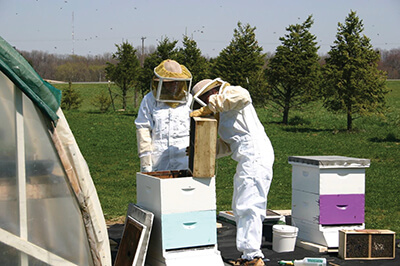
On a sunny spring day in April of 2005, I set up my first beehives in the lovely little part of the world I call my home in southwest Michigan. They found themselves living in a bee paradise with lots of forage, abundant water, wild areas, hay fields and a lawn filled with white clover. They rewarded me year after year with honey harvests ranging from 60 to over 100 pounds per hive. Even in a poor year they averaged around 50 pounds per hive. I kept around five to seven hives in groups of three or four per location scattered throughout my property and my neighbor’s.
Suddenly that all changed. My hives struggled. For the first time ever I saw a hive decrease its honey stores from one inspection to the next. A swarm collected in May never increased in size at all, even though the queen was always present at every inspection. By fall, two hives were so light I almost knocked them over when I went to staple winter wrap on them. What could have happened?
It wasn’t as mysterious as it sounds, although it took me a lot longer than it should have to recognize the problem. A large commercial beekeeper placed 30 hives right near my property line. I contacted him and requested he move them, but he was unwilling. He cryptically stated that he had more hives near me than I knew. I didn’t really think about that at the time, but these extra hives added a lot of competition for the same forage.
By the time I finally did notice my light hives, I discovered that they were completely empty — robbed clean. I found 45 more hives a mile down the road and there was my answer. There had been plenty of forage for five to seven hives, maybe even ten to fifteen, but definitely not for 80. Well, ever the optimist, I figured a new year would be better and cheerfully fed enormous amounts of sugar to the remaining hives to help them through the winter.
Spring arrived, so did the commercial beekeeper. This time with 144 hives. I only had one hive left by spring. It went queenless just as my four new queens arrived. I desperately split it into four and placed new queens with each split. I quickly realized they could never survive the competition of 144 hives. Time to move. But where? How could I be sure that the new location was free and clear of the competition?
I used two tools – one old and one new. First, I traveled the roads all around and looked very carefully for signs of beehives. The previous year I hadn’t noticed the 45 hives because of tree cover. I learned to look very closely at any potential location. I knew that for a location to be attractive to the commercial beekeeper, it had to have good access for his large trucks and had to be a vacant piece of land that was not under active agricultural cultivation. The other method was to study Google Satellite Maps of our area. There is a feature on those maps that allows me to measure distance to determine how far one point is from another. This is very useful when determining apiary locations, as you can calculate foraging range.
I first had to determine what was desirable to the commercial beekeeper. He needed a location that would be undisturbed throughout the growing season. That rules out any cultivated fields. From a satellite view I can see what is farm land and what is vacant land. I knew one of his locations was a gravel pit. Those are very easy to see on a satellite map.
I could pinpoint where his hives were located and measure a three mile radius around them. His hives were located in two locations that were one quarter to one mile from my hives. I then used the Google Maps tool to measure distances from the commercial beekeeper’s hives to three other nearby beekeepers, all of which were new beekeepers with only one or two hives.
I knew a friend of mine had an appropriate piece of property for colonies, in fact bees had been kept there in the past very successfully. I asked my friend if he had seen any evidence of commercial beekeeper activity nearby. He had not. He owns a large area of land – another ….


